Convert audio files
– here's how it's done.
Want to convert your audio files to WAV, AIFF, CDA, MP3, AAC, WMA, FLAC, and other formats? Keep reading to find out how.
- Install Samplitude Music Studio and start a new project.
- Select "File" > "Import" > "Load audio file" and import the audio files that you want to convert. To import audio CD tracks in CDA format, insert the audio CD into your computer's drive and select the "Import audio CD track(s)" option from the "CD" menu. Then, select the tracks you want to import in the Import dialog and click "OK".
- When you load multiple files into one project, the files appear one after another as objects in the first track. You can convert them all into one long audio file, or you can convert each object separately. To do this, place an editing range over the file. Click the object in the lower half of the track to select it and then select "Edit" > "Range" > "Edit range" > "Range over all selected objects".
- To convert the selected range or the entire project, select "File" > "Export" from the menu and then one of the available formats. The available formats are WAV, MP3, AAC, Windows Media (WMA), FLAC, Ogg Vorbis, and AIFF.
The easy way to start producing music
Turning concepts into chart hits. It's time to put your ideas on stage. Bring your musical vision to life. Kick-start your music production with Samplitude Music Studio software. Use powerful, flexible and creative options to easily compose, record, mix, and master your songs. Use innovative tools and object-oriented workflows to create complex arrangements. Choose from a wide selection of essential sound tools to prepare your songs for the stage. Discover Samplitude Music Studio. Everything you need for your music.
Start your free trial nowConverting music formats – the fundamentals
Music formats are converted for different purposes. If an audio player cannot play certain formats, files need to be converted to a compatible format. More commonly, it's a matter of compressing audio files, i.e. making them smaller. Smaller files save storage space and allow smooth playback over the Internet.
The most common music formats are WAV, CDA, MP3, AAC, OGG, WMA and FLAC. While WAV, CDA and FLAC are lossless, i.e. do not generate any quality loss compared to digital audio recording, other formats such as MP3, AAC, OGG or WMA are "lossy".Depending on the bit rate, this reduces the file size by varying degrees.
The amount of data reduction cannot be specified exactly – it depends mainly on codec settings, as well as the acoustic material. For example, a simple voice recording generates less data than a complex song that fills all frequency ranges. Nevertheless, as a general rule of thumb, it's possible to reduce a normal song to about one 1/10th of its original size without any (noticeable) audible difference. This means that a song file that is 50 MB in WAV format will typically be 5 MB after compression to MP3, AAC, OGG or WMA and have more or less the same sound quality.
In the following, you'll learn more about the attributes of each audio format.
MP3 – the mother of all compression
It all started with the MP3. When portable MP3 players appeared, it became possible to store hours of music in a small space and carry it around. A little later, the Internet turned into a huge, partly illegal hub for MP3 songs. Thus, file-sharing networks came into being. Today, the MP3 continues to be the best-known and most widely used audio format in the world, alongside WAV.
The idea behind the MP3 is to create files that are as small as possible in order to save storage space, but at the same time retain the highest possible sound quality. It uses a sophisticated psychoacoustic process developed by the Fraunhofer Institute in Germany: What is audible to humans is preserved, but the inaudible parts of the sound spectrum are removed from the data or at least reduced in resolution.
The amount of compression – the so-called bit rate – can be specified. 192 kBit/s (kilobytes per second) correspond roughly with CD quality. Lower bit rates are used for Internet radio, for example, where the amount of data should be as small as possible so that you can stream without dropouts.
FLAC – the lossless format
FLAC is the only one of the compression processes featured here that offers lossless compression. This means that your audio recording will sound exactly as if it hadn't been compressed. MP3, WMA, OGG and AAC use psychoacoustic compression methods, which means that the original data is changed during compression. FLAC only changes the way the data is rendered, so that it is packaged more efficiently.
However, lossless compression is compensated for by the fact that the files are larger. MP3 files, for example, are around 1/10th of the original file's size, while FLAC roughly halves the size of the original file. Furthermore, many playback devices do not support FLAC.
If you want to archive a music collection in the most efficient way, for example, FLAC is the best option because it doesn't compromise any sound quality. For portable devices or streaming, however, MP3 is the better choice.
WMA – another alternative to MP3
Aside from OGG Vorbis, there is a third alternative to MP3 – WMA. WMA stands for Windows Media Audio, was developed by Microsoft and is a product competing with the MP3. For a normal user, there is not much of a difference between MP3 and WMA.
So now the question arises at the latest: Which format should you use when there are three more or less equivalent alternative options?The answer depends on where the file will be played. As mentioned, WMA is Microsoft's audio codec, and not all audio players recognize WMA format. If you want to play a WMA file on a computer, this can be done easily using Windows Media Player or VLC Player.
However, mobile devices or hardware players may not support this format. You might be better off with MP3 – this format is supported by (almost) every player.
WAV – the original
The good, old WAV file is the "mother" of all audio formats. It is part of the Windows operating system and is therefore ubiquitous in the computer audio world. The WAV format produces uncompressed audio in the best quality – but with the price that files in this format are comparatively large. Most often, WAV files should be converted to compressed formats so that the files become smaller.
However, sometimes the opposite is true: Compressed audio files such as an MP3, AAC, WMA or FLAC are converted to WAV, for example, so that they can be played and edited on a Windows computer without any problems. Most audio programs, however, meanwhile perform the conversion automatically. This means you can directly import an MP3 or WMA file, play it, edit it and then save it as MP3, WMA or in any other format.
During this process, the program first converts the file to WAV, plays or edits it as a WAV file, and finally converts it again. This is all done in real time, without you noticing anything. In other words, normally you don't convert audio files to WAV, but rather the other way around – as WAV files to other formats.
With an important exception: CDA.
CDA – audio CD tracks
CDA stands for CD Audio and refers to a track from an audio CD. CDA files, like WAV files, are also uncompressed. However, they are not files intended for playing or editing on a computer, but rather for playback using an audio CD player. As a result, they are not readable by the computer's Windows operating system.
To play or process CDA tracks on a computer, they must first be converted to WAV files. This process of transferring music CDs to MP3 is also called "ripping" and "grabbing".
AAC – a new development
AAC is a more modern, but also lossy compression format. It differs from MP3, OGG and WMA technically by using a different method. Better quality is achievable with the same data rate. In this regard, AAC is the best choice for lossy formats. The disadvantage is that not every player supports AAC.
The same applies to WMA: Certain players may not support the format. With MP3, you are on the safe side – this format is supported by (virtually) every player.
OGG Vorbis – the free alternative
Many people think that OGG files are the free open source alternative to MP3. Strictly speaking, this is only partly true: OGG files are actually container files for multimedia applications, they can also contain video and text as well as audio. Only when an OGG file is combined with the Vorbis audio codec does it become an OGG Vorbis file, which is a free MP3 alternative.
The best conversion software
Once you know which format you want for the conversion, you will need the appropriate conversion software. There are a number of free audio converters on the Internet that can do the job. In most cases, however, it's more practical to be able to perform some editing in addition to the actual conversion, such as cutting out unnecessary parts, enhancing the sound, removing pops, or matching the volume and sound of several recordings and editing them together.
That's why we recommend Samplitude Music Studio, which is in fact a complete virtual home studio for music production, in addition to conversion tasks.Samplitude Music Studio is the small, more affordable sibling of Samplitude – the renowned pro software for professional music production.
Samplitude Music Studio is actually designed for aspiring musicians and bands. It enables them to record their music at home, add additional VST recordings to the recordings, as well as edit them with professional effects and mastering tools. But Samplitude Music Studio is also perfect for "mundane" conversion tasks.
Here's how you do it:
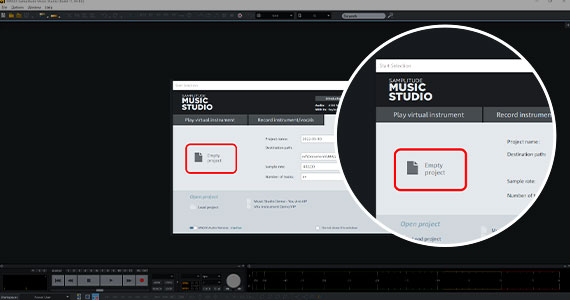
Start Samplitude Music Studio
- Start Samplitude Music Studio and create an empty project using the start dialog.
This opens a new multitrack project with empty tracks.
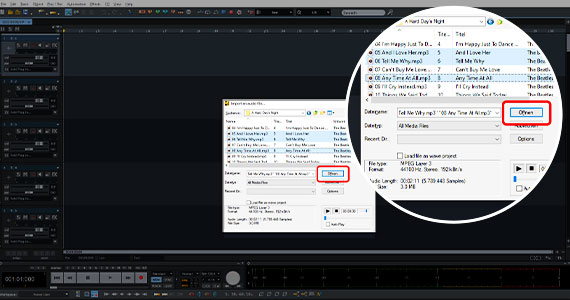
Load the audio files to be converted and, if necessary, edit them
- Select "File" > "Import" > "Audio CD track(s)" or simply press the "W" key.
- Load your audio files in the "Load audio file" dialog.
You can also used this dialog to select and import several audio files. To do this, click the files one after another while holding down the Ctrl key.
Alternatively, you can simply drag & drop the audio files directly from Windows Explorer into the project window.
- To import audio CD tracks in CDA format, insert the audio CD into your computer's drive and select the "Import audio CD track(s)" option from the "CD" menu. Then, select the tracks you want to import in the Import dialog and click "OK".
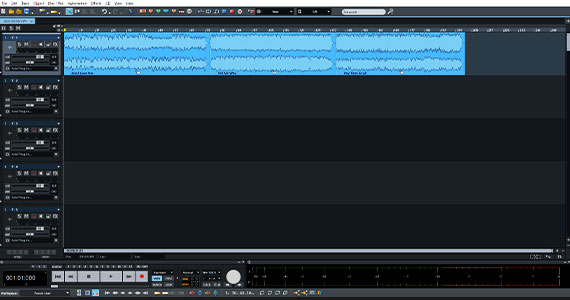
All imported audio files will be inserted consecutively in the selected track (usually track 1).
Now, you can edit the audio files in a variety of ways. For this purpose, Samplitude Music Studio offers such an impressive variety of tools that we can't even list them all. A few examples:
- To crossfade multiple audio files into one another, move them onto two tracks and create a crossfade using the object handles. Note that clicking in the lower half of the track will move an object (the upper half is used to set ranges).
- To apply object effects, click on an audio file and set the desired editing effect in the "Effects" menu. This is where you can access various compressors and equalizers, professional noise reduction and noise removal, reverb, echo, filters and time-stretching, and more.
- Press the "M" key to open the mixer. Here, you can find more track and mastering effects as well as adjust the volume of individual tracks.
It is also possible to skip any editing and simply convert the imported audio files to the desired output format.
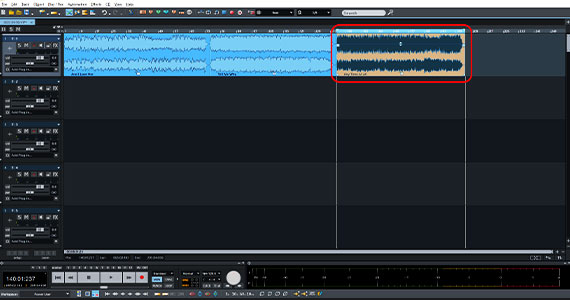
Convert audio files
If you don't want to convert the entire project, specify the range above the object you want to convert first:
- Click the object in the lower half of the track to select it.
- Select "Edit" > "Range" > "Edit range" > "Range over all selected objects".
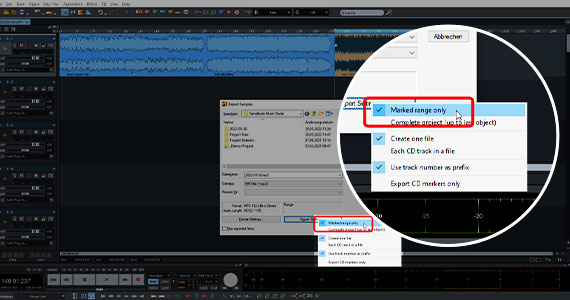
Now, the range is placed over the entire length of the object and it can be converted into a separate audio file.
- Select "File" > "Export" and then one of the available formats.The available formats are WAV, MP3, AAC (following fee-based activation), Windows Media (WMA), FLAC, Ogg Vorbis, and AIFF.
- To export the range, click the "Export settings" button in the Export dialog and activate the "Only selected range" option.
- If you want to check or change the encoder settings, click "Format settings". This is where you can increase the bit rate, for example.
- If everything is correct, click "Export". This starts the conversion process.
Samplitude Music Studio: Everything you need for your music
Samplitude Music Studio is there wherever you need it. From the first to the last note, and from your garage to the stage. A compact, all-rounder that provides incredible performance, whether for composing, recording, mixing or mastering.
Start your free trial now
